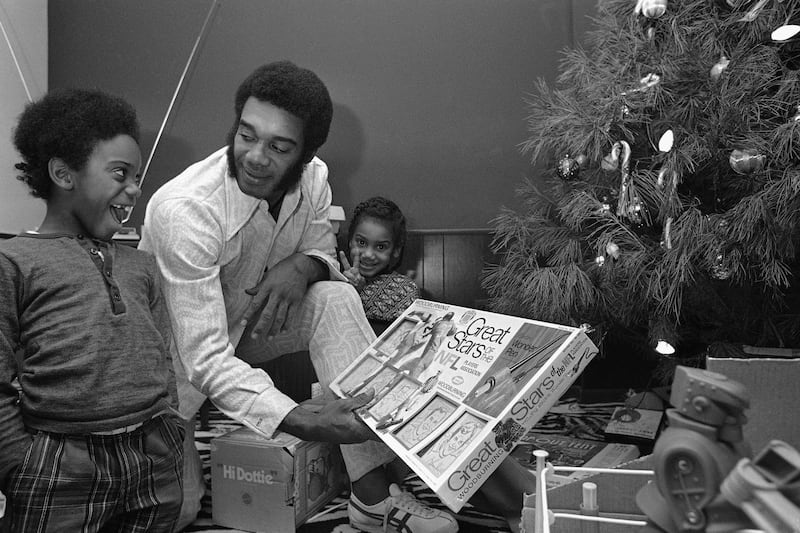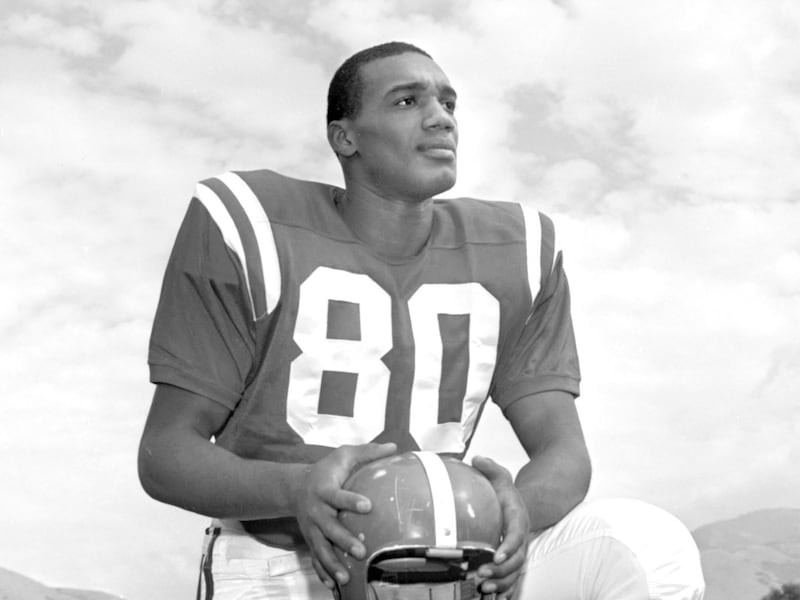This article was first published in the Ute Insiders newsletter. Sign up to receive the newsletter in your inbox each Wednesday night.
Smith Snowden and Lander Barton have been garnering a lot of attention after playing on both offense and defense to start the season.
Snowden played cornerback but also contributed 51 yards on six catches, plus 15 yards and a touchdown on the ground in the Utes’ season-opening victory over UCLA. Linebacker Barton had his first-ever reception — a 14-yard touchdown pass from quarterback Devon Dampier.
With the success Utah’s two-way players have enjoyed to start the season, it’s appropriate that one of the most prominent do-it-all players in school history will be honored Saturday.
Roy Jefferson, who played receiver and defensive back at Utah from 1962-64, will be inducted into Utah’s Ring of Honor at halftime of Saturday’s game alongside coach Ron McBride, who revitalized the football program in the 1990s.
“I was very surprised about it and I’m very excited about them honoring me,” Jefferson told the Deseret News this week.
“... It was a very happy time around the Jeffersons’ household.”
Getting his start in Salt Lake City
Jefferson starred for Compton High in Los Angeles in the late 1950s and early 1960s alongside his cousin, Marv Fleming. Jefferson showed flashes of his two-way talent at Compton, and received interest from a number of schools, including right in his backyard.
Jefferson was planning on playing college football at nearby UCLA — the Bruins started contacting him as early as junior high school — but Fleming, who graduated before Jefferson and went to Utah, extolled the virtues of playing in Salt Lake City.
“Athletically, the guy was kind of heads above almost everyone because he had that rare composite of speed, attitude, athletic, everything.”
— Dan Spinazzola, a running back who played with Jefferson at Utah
“I was strongly planning on going to UCLA and then my cousin Marv would start talking to me about going to Utah when he saw that they were recruiting me and that’s when I focused a little bit more in on Utah,” Jefferson said.
During his recruiting trip to Salt Lake City, Jefferson’s interaction with his future teammates and the coaching staff, headed up by Ray Nagel, sealed the deal for Utah.
Jefferson arrived at Utah ahead of the 1962 season and settled into life in Salt Lake City.
“It’s just a world difference of an experience. So his experience coming from California to Utah, I can say was a different experience entirely, especially being at the bottom of the mountains in the valley,” said Candie, Jefferson’s wife of 62 years who he met at the University of Utah.
From the moment he first suited up at Utah, it was clear that Jefferson was going to be a star.
“Athletically, the guy was kind of heads above almost everyone because he had that rare composite of speed, attitude, athletic, everything,” said Dan Spinazzola, a running back who played with Jefferson at Utah.
During his first season with Utah, 1962, Jefferson earned All-WAC status by catching 18 passes for 336 yards — averaging 19.8 yards per reception during his freshman year — and scoring three touchdowns while also playing cornerback.
Jefferson was one of the highlights of a pair of teams that posted four-win seasons, racking up a WAC-high 435 receiving yards and four touchdowns on 23 catches in 1963, placing him just outside the top 20 nationally.
In 1964, however, led by Jefferson and running backs Allen Jacobs (752 yards, eight touchdowns) and Ron Coleman (750 yards, five touchdowns), Utah’s offense took a leap and its defense was one of the best in the nation. The Utes shut four teams out and allowed less than seven points in four other games.
“Ron Coleman was our running back guy, a little guy, but he was good,” Jefferson said.
The Utes went 2-2 to start the 1964 season, but after a 14-13 loss to Wyoming, the Utes won six straight to close the regular season, including a 47-13 victory over BYU and a 14-6 win over Utah State in the season finale.
“BYU and Utah State, those two teams we had to beat. So that was part of success when you attend the University of Utah,” Jefferson said.
Jefferson earned All-America honors after catching 24 passes for 395 yards and two touchdowns, just behind John Pease (23 catches for 406 yards and two scores), who would later serve as the Utes’ defensive coordinator in 2015.
On defense, Jefferson had three interceptions while playing both ways.
“I loved it. I didn’t want to come off of the field,” Jefferson said. “They had to drag me off the field.”
If that wasn’t enough, he also was the team’s field goal kicker, making 18 PATs and four field goals, a skill he honed while at Compton High.
“It’s what I did, all my career in junior high, high school and college,” Jefferson said of his do-it-all ability. “So it was nothing new to me and I had always done it very well. It’s just a continuation of the things I always had done on the field.”
Utah’s 8-2 regular-season record earned the Utes a trip to their first bowl game since 1938. The 1964 Liberty Bowl, played at the Atlantic City Convention Hall, was the first major college football game to be played indoors.

The Utes were pitted against West Virginia (then in the Southern Conference) and Jefferson wanted to show a nationwide audience on television what Utah was all about.
“They talked about us like we didn’t know anything about football. Everyone said Utah who? We showed them who Utah was,” Jefferson said.
Utah raced out to a 19-0 halftime lead and defeated West Virginia, 32-6.
Jefferson made two field goals during the first half, but separated his shoulder and was unable to finish the game. Even with the injury, the Liberty Bowl championship was the culmination of his career at Utah and a high-water mark for the program as a whole.
“The highlight of my career at Utah was the Liberty Bowl,” Jefferson said.
NFL success
Jefferson was drafted No. 18 overall in the 1965 NFL draft and No. 14 overall in the AFL draft. He had a choice to make between the two leagues, and chose to go with the NFL and the Pittsburgh Steelers.
In his five seasons with Pittsburgh, Jefferson totaled 3,671 yards and 29 touchdowns, leading the NFL in 1968 with 1,074 receiving yards and 11 touchdowns. The next year, he had 1,079 receiving yards and nine touchdowns, good for second in the league.
Jefferson accounted for 44% of the Steelers’ receiving yards in 1969.
Even as he enjoyed on-the-field success, he and new coach Chuck Noll butted heads, partly over the brief 1970 players’ strike (Jefferson was a representative for the NFL players’ union at the time), and in response to the impasse between coach and player, the Steelers sent Jefferson to Baltimore in a trade ahead of the 1970 season. Jefferson spent just one year with the Colts, posting 749 yards and seven scores on 44 receptions.
Led by Johnny Unitas, Baltimore defeated Cincinnati and Oakland to earn a spot in Super Bowl V against the Dallas Cowboys. In a game that featured 11 combined turnovers, Jim O’Brien made the game-winning field goal to give the Colts their first-ever Super Bowl championship.
Jefferson caught three passes for 52 yards in the win.
“I happened to get traded to the Baltimore Colts and boom, what happened? We won the Super Bowl,” Jefferson said.
In the offseason, Jefferson was traded to Washington, where he spent the last six seasons of his career. He earned his third and final Pro Bowl appearance in 1971 with the Redskins after a 701-yard, four-touchdown season.

In 1972, he helped the Redskins to Super Bowl VII. Jefferson had a good game in the loss, leading Washington with five receptions for 50 yards, but his cousin Fleming and the Miami Dolphins would win, 14-7.
Jefferson would play for four more seasons in Washington after that before retiring after the 1976 season. He finished his 12-year NFL career with 7,539 receiving yards and 52 touchdowns.
Taking a stand off the field
Off the field, Jefferson, who is Black, led a protest against racial discrimination in Salt Lake City in 1965 and spoke at the march about his experience being turned away from housing in Utah due to his race.
“I’m from Salt Lake City, Utah. And to see some of the things that happened, it was important for people like my husband to speak out, because people recognized him as an athlete, to speak up for what he thought was equality and for the rights of the people,” Candie said.
Jefferson would later go on to be a players’ union rep during his NFL playing days, fighting for better treatment and pay for players.
Long before the megadeals of today’s NFL players, Jefferson made $17,500 in his rookie season, according to a DK Pittsburgh Sports article, which is equivalent to about $179,471 today.
During the offseason during those early days in Pittsburgh, Jefferson worked at U.S. Steel, which helped pay for him to go back to college at Utah and obtain his degree in physical education.

“I was excited about coming back to school and getting my degree and that was just important to me,” Jefferson said.
During his final year in Washington, Jefferson was one of the lead actors in “The Brotherhood of Death,” a 1976 film that portrays three Black men returning home from fighting in the Vietnam War and battling racial prejudice and the Ku Klux Klan.
Ronald K. Goldman, the executive producer of “The Brotherhood of Death,” decided to save some money on the film and generate some buzz by hiring some Redskins players to act in the movie.
Though the film was mostly panned by critics, it remains a favorite of acclaimed director Quentin Tarantino, who has screened it twice at his film festival.
Returning to Utah
Jefferson has been back to Rice-Eccles Stadium a few times since his playing days, including a couple of years ago, but this visit is special.
Jefferson will be able to see his name be enshrined forever on the west side press box, and be able to hear the cheers from the Utah crowd once more.
“I love my alma mater and I like to see how they’re doing. So this gives me an opportunity to be there in person and celebrate with them and hopefully celebrate a victory,” Jefferson said.

In case you missed it
Devon Dampier and Jason Beck’s Utah debuts couldn’t have gone much better as the Utes defeated UCLA 43-10 in the Rose Bowl.
From the archives
Extra points
Here’s what’s new at Rice-Eccles Stadium this year
These 75 Utah ties are on an NFL roster to start the season
Big 12 power rankings: How Week 1 shook up the conference picture


